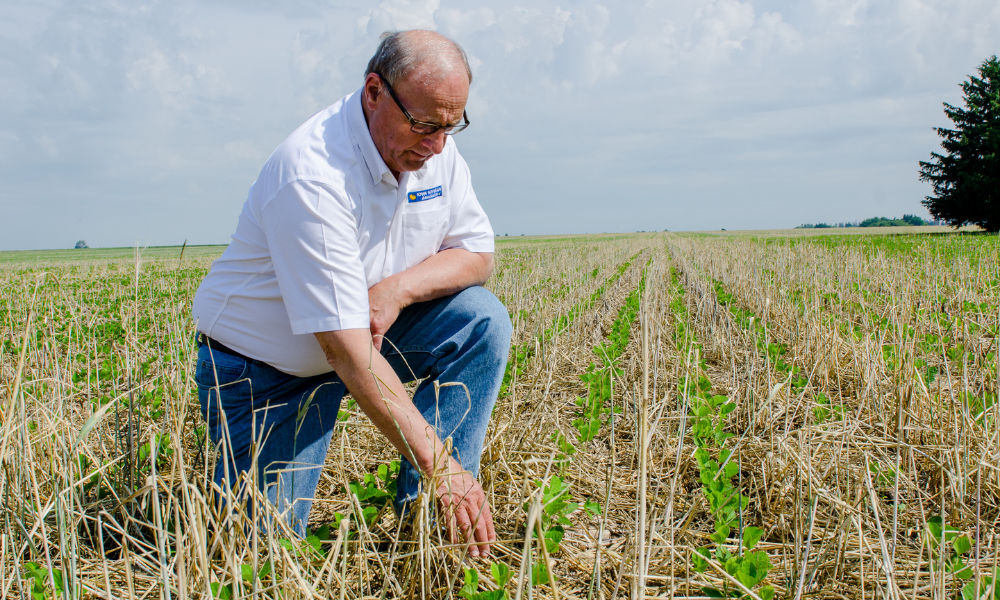
Wayne Fredericks, an ISA member from Osage, checks the progress of his soybeans that he planted into a rye cover crop prior to terminating. (Photo: Joseph L. Murphy/Iowa Soybean Association)
How (and why) four farmers are dedicated to the cover crops cause
January 20, 2021
Four Iowa farmers. Three unique defining moments. One commitment to using and advocating for cover crops.
It sounds like the dramatic opening to the newest winter blockbuster, but it’s the simple truth for Rob Stout, Wayne Fredericks, and Ray and Chris Gaesser. Across the Midwest, these early cover crop adopters are well-known on farm speaking circuits as they share their experiences with and support for planting cover crops to improve soil health and water quality, and strengthen economic outlooks.
Watersheds and neighborhood network
Washington County is a state leader in the number of planted cover crops and the area’s farmers are recognized for their innovation and commitment to conservation. Rob Stout is one of those innovators.
His operation started using no-till four decades ago after he and his dad attended a local meeting.
“Back then, just like today, we looked to the science and the results with no-till,” recalls Stout. A few years later, they moved forward. “The neighbors noticed. People notice when someone is doing something different. Soon, others were asking us about what we were learning.”
It didn’t take long before county farmers were gathering around Stout’s kitchen table, learning more about conservation and the cover crops he added in 2009. They also rallied around a new-at-that-time concept called watershed planning. Stout’s group became one of the first groups to establish a watershed plan with the Iowa Department of Agriculture and Land Stewardship (IDALS).
“Eleven years ago, we created the West Fork Crooked Creek Watershed plan and were one of the first plans to receive IDALS funding,” Stout says. “That was a pivotal moment for us and helped create a blueprint for us to follow. I’d say that was our defining moment in this area.”
Stout, who farms today with his stepson Alex Zimmerman, says that effort will continue through Zimmerman’s passion for conservation.
“We keep beating the roads and bringing in new people and new neighbors each year. This results in more acres of conservation efforts,” says Stout. “I know I’m at 100% cover crops on my own acres, so if I really want to help increase acres, I need to find new people.”
Powerful pictures
It’s often said that pictures tell the real story. When it comes to telling his cover crop conversion story, Wayne Fredericks of Osage is quick to put that statement into action.
When he leads presentations, he displays photos of green cover crops in December, thriving monarch and wildlife habitats, and the farm lake.
Fredericks doesn’t have a lake in his yard, but his backyard looked like one after intense rains in 2008. The “lake” and resulting water movement became his defining moment.
“I’d never seen so much water accumulate so quickly. And, a few days later, Cedar Rapids experienced terrible flooding,” says Fredericks. “It made me realize how what happens here impacts things downstream. I wanted to do my part.”
The data-driven farmer went to work. It took years of careful management changes and research to bring the farm acres into 100% cover crop coverage. The data is showing the facts: improvement and increase in organic matter and strong yields. “My organic matter has increased 2% in 20 years of no-till and cover crops will continue to enhance that effort.”
When he presents, his careful mix of beautiful photos and powerful agronomic and economic stats has farmers paying attention.
“I work to bring my big picture information to the farm level, tell a compelling story, share the mistakes with the wins and keep learning,” says Fredericks.
Changes for the climate
Father-son team Ray and Chris Gaesser’s entry into cover crops was due to extreme weather conditions that made them step back and consider what else they could do.
Intense rainfall in 2010 that brought four inches in one hour was a defining moment for them. The team had been no-tilling for years, but knew they needed to evolve. After learning more from organizations in which they were involved, adding cover crops to their system was the next step.
“Cover crop adoption is still in the minority, but every year more people seek info and try. Because we believe in and know the benefits, we want to serve as a resource,” Ray says.
In the 1980s, Ray says they were the only area farmers no-tilling. Today, he sees drastic change, guessing that more than 80% of area farmers are doing no-till. He hopes to see cover crop acres see that growth.
Innovation and involvement are two key characteristics of the Gaesser Farms team. As conversations about the conservation and climate continue, the Corning-area farmers are active in several ag groups and share their experience with other farmers.
“The world is changed by action, not just opinion,” says Ray. “We’re not only learning things from groups like the Iowa Soybean Association, they offer us the opportunity to share how we are implementing those resources on our farm and allow us to be resource to others.”
This story was originally published in the January 2021 issue of the Iowa Soybean Review.
Back